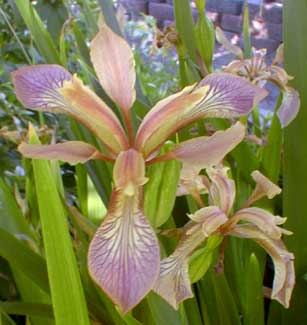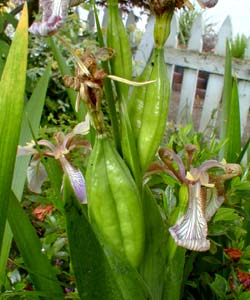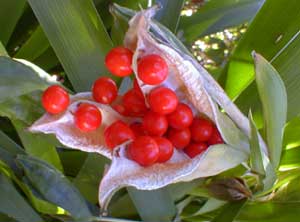
Stinking Iris; or,
Coral Iris; or,
Gladdon Iris; or,
Stinking Gladwyn; or,
Gladwin Sword Iris; or,
Roast Beef Plant
"I saw an idler on a summer day
Piping with Iris by a dancing brook;
And all his world was rife with Pleasures gay,
And languid Follies smiled from every nook."
-Martha Gilbert Dickinson Bianchi
(1866-1943)
(1866-1943)
This thoroughly evergreen iris loves moderate shade but also does well in considerable sunlight. It grows to three feet tall or so, with large evergreen sabres of leaves that simply never fade away in the manner of the vast majority of irises.
There is no better iris for a "permanent" feature of sword leaves, though where winters fall into the teens Fahrenheit, the leaves may be damaged & need to be thinned late in winter to remove injured leaves, being quick to recover in spring. In our moderate winters, Iris foetidissima has no leaf damage in the least.
Our red-fruiting gladwyn iris is in a dappled shade garden underneath a large Choke Cherry. It began as two slender starts, but three years later their rhyzomes had spread to form one very big broad clump, a real centerpiece of attention twelve months of the year.
 Dusky purple & pale lilac beardless flowers with dark veins are often said to be minor, but I think they compare favorably to the majority of wild irises. Because we planted such tiny starts, it did not bloom the first two years, but when matured it bloomed handsomely with lots & lots of spring & early summer flowers.
Dusky purple & pale lilac beardless flowers with dark veins are often said to be minor, but I think they compare favorably to the majority of wild irises. Because we planted such tiny starts, it did not bloom the first two years, but when matured it bloomed handsomely with lots & lots of spring & early summer flowers.The flowers sit a little low among the green sabres, rather than rising above & setting themselves off a great deal, but they're otherwise classic-looking iris beauties.
Blooms begin the first half of May, not opening all at once so that flowers are present longer than for many irises. New flowers are opening for about four weeks, the bloom portrait at top of this page having been snapped in early June toward the end of this long bloom cycle. Each bloom after only a few days begins "going to pod."
Beneath each fading flower a large green seedpod rapidly develops. The green pods are shown in the second June photo, with spent blooms still adhering at their tips.
These pods mature through the summer then in autumn they burst open into a fabulously showy display of bright orange seeds which last into winter. The final photo was snapped in late September. The clump had produced such large & heavy pods that they fell over & eventually needed staking, but they're not invariably floppy-stemmed seeds. Or, rather than staking an over-productive stem of bright berries, it can also have a portion of the burst pods harvested to make each stem lighter.
 It is these seeds that are widely regarded as the primary ornamental boon. The burst seedpods make good cuttings for bouquets. As cuttings they last even longer than they do in the garden.
It is these seeds that are widely regarded as the primary ornamental boon. The burst seedpods make good cuttings for bouquets. As cuttings they last even longer than they do in the garden.It can be grown from these seeds, but takes a very long time, & propagation is more swiftly done by division of the clump. The seeds can take a year & a half to germinate, then the resulting plant can take another two years to bloom & produce the colorful seeds. The best way to grow them from seeds is in cold frames, planted in autumn as soon as the seeds have ripened.
It is native of northern Africa & southwestern Europe. It has naturalized far from its original range, in many places throughout Europe, & in North America it is categorized as an invasive weed in Nevada.
It likes best moderately moist neutral pH soil but it has thrived beautifully in our naturally acidic soil. It does not suffer from occasional dryness & becomes increasingly drought-hardy with age, so is one of the best for that finite list of "dry shade" plants. It can tolerate maritime conditions & is a good choice for cliffs overlooking the sea.
Though saddled with the unfortunate name of Stinking or Fetid Iris, garden specimens don't ordinarily have any odor. I'm willing to believe that in the wild its leaves release an odor if smashed & trampled. But my attempts to induce the leaves to release even a moderately bad odor have failed; the clumps we have simply do not stink.
Perhaps if I dug it up & stomped all over the roots, the odor of cooking roast beef would be released as claimed, lovely though it is to realize there are people other than vegetarians like myself who regard the odor of roast beef as a horrid stench.
The blossoms themselves have a very mild scent, hardly noticeable unless you put your nose right inside the bloom, & perfectly pleasant if detectable. "Stinking" is simply overall the wrong name, & I suspect it would be a more popular if one or another of its alternative names were to become increasingly used.
It is sometimes called Coral Iris, alluding to the beautiful coral-bead berries. The second-most common name after "Stinking Iris" is variously rendered Gladwyn, Gladdon, Gladen, or Gladwin. It seems odd that no standard spelling has evolved, but Gladwyn would be the superior choice of name, since it means "Sword-grass."
The rhizomes are toxic but have in times past been used medicinally for cramps & other ailments, & has been alleged to be an effective topical treatment for ringworm. Its potency attracted medieval & early renaissance alchemists. As it is dangerous taken internally, it has not survived as part of modern pop-herbalism.